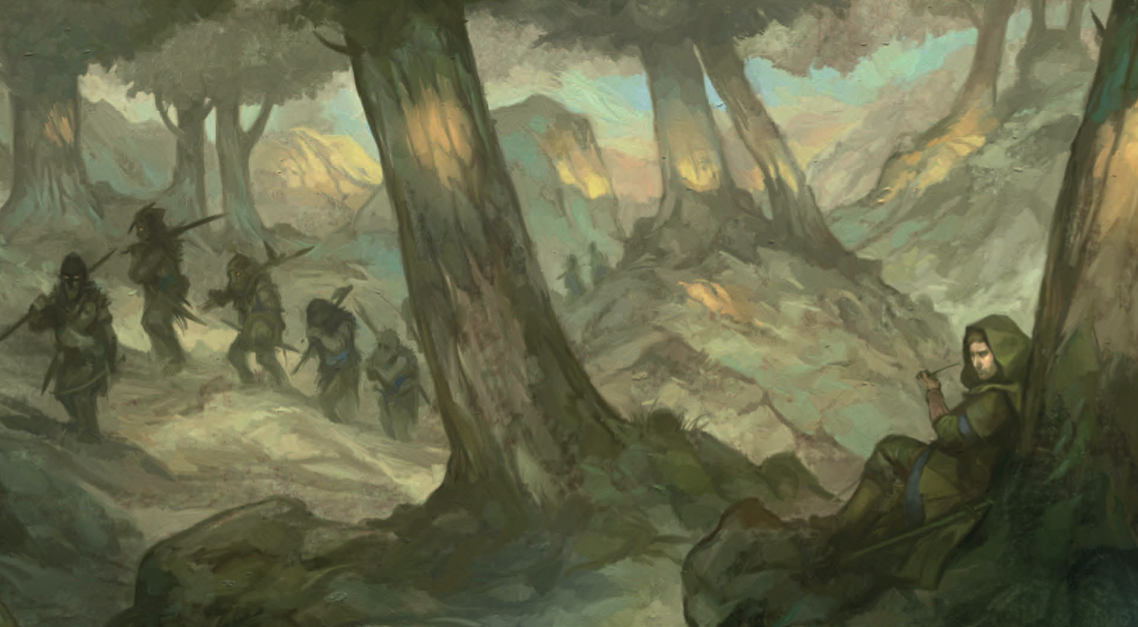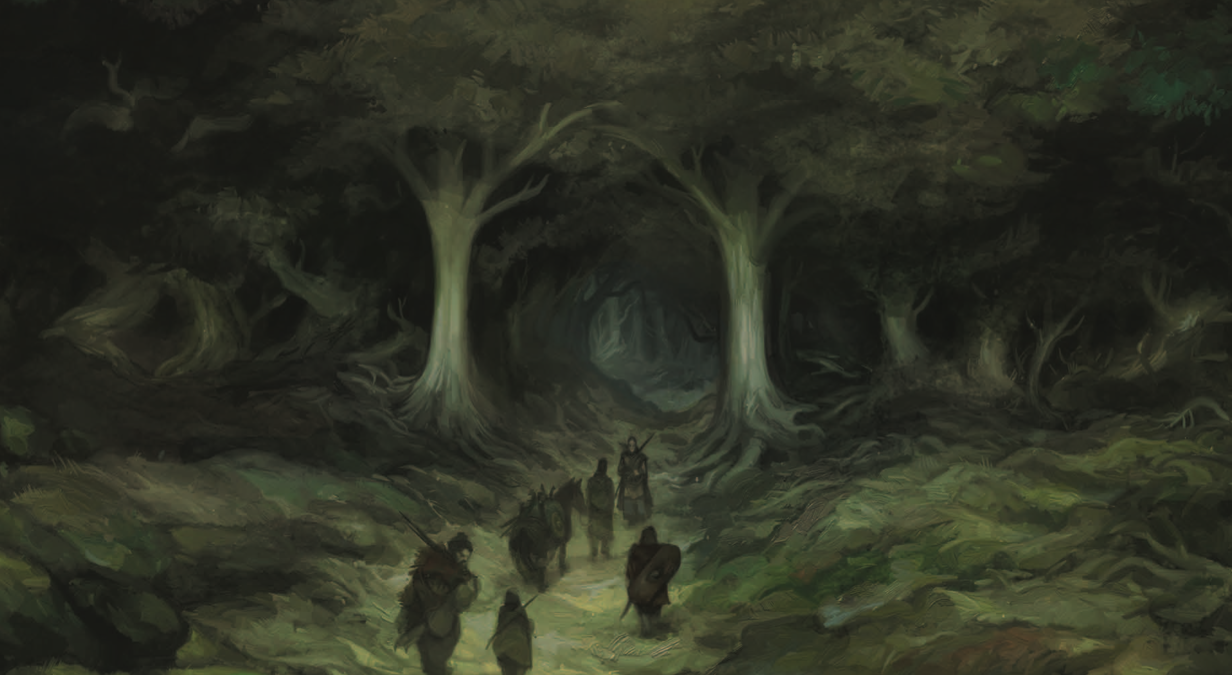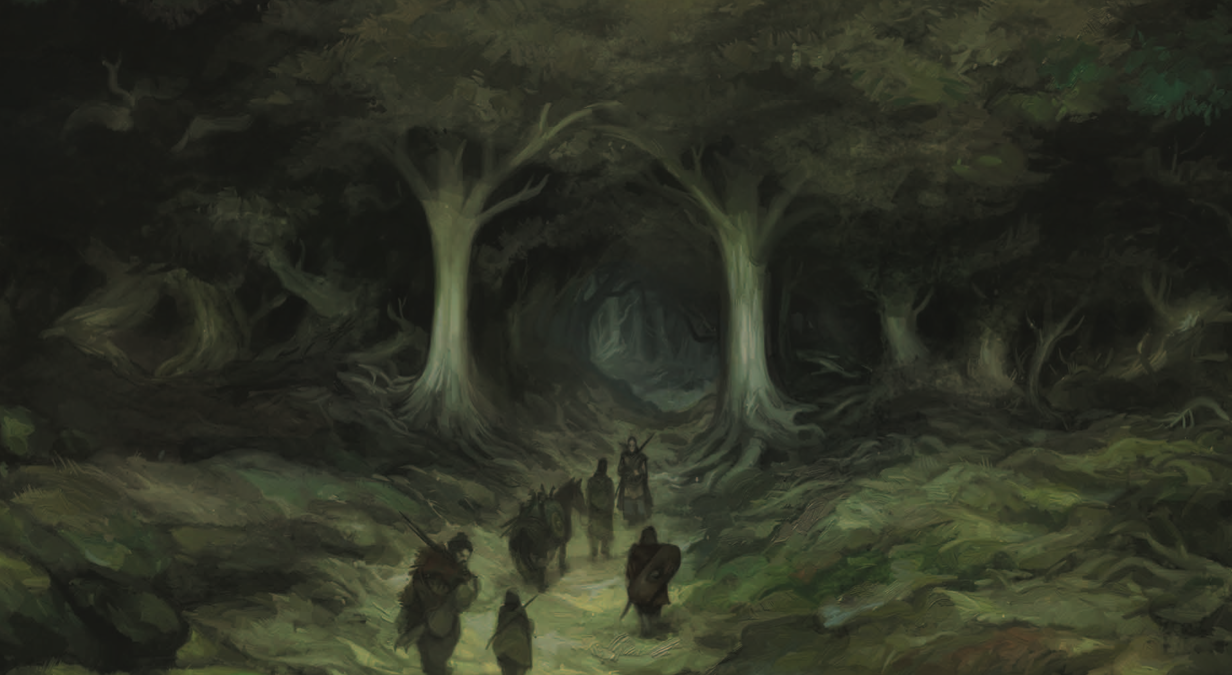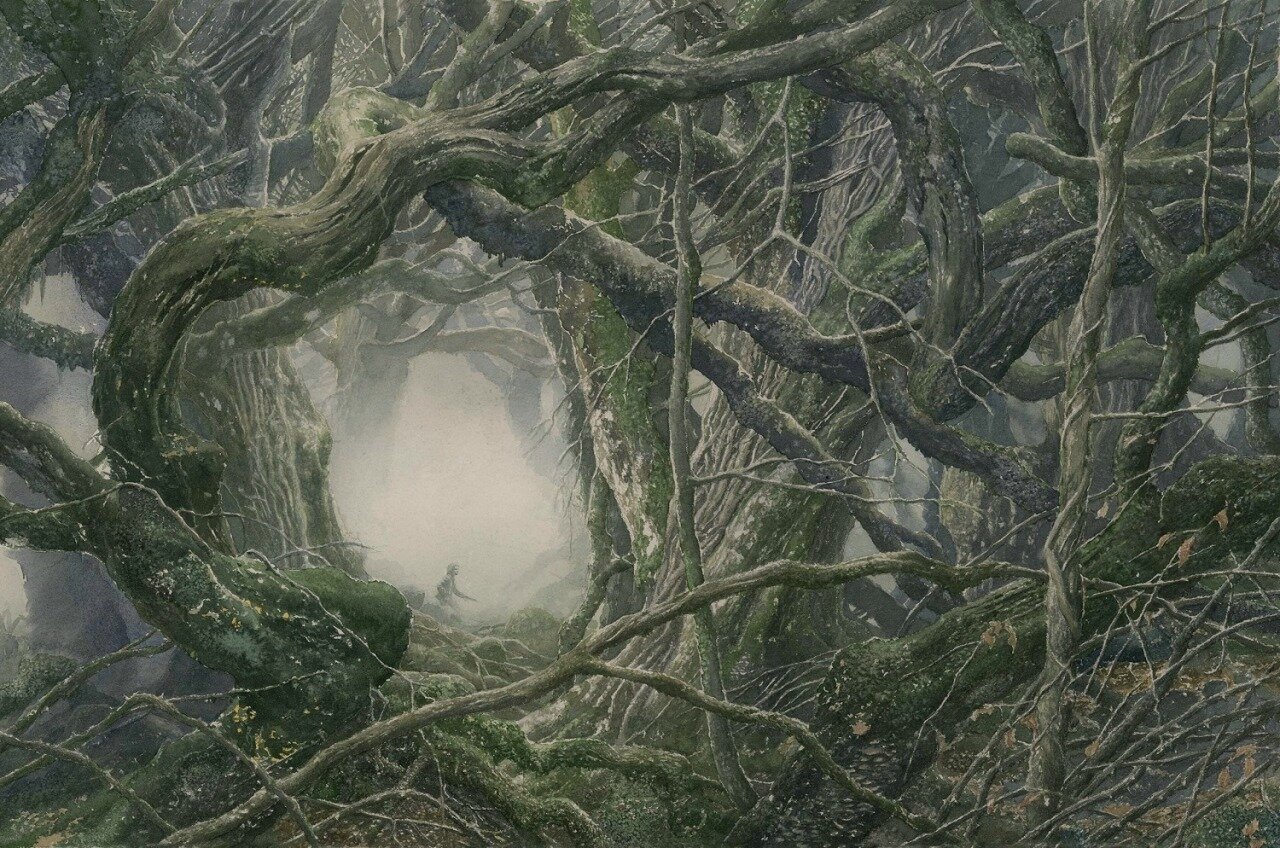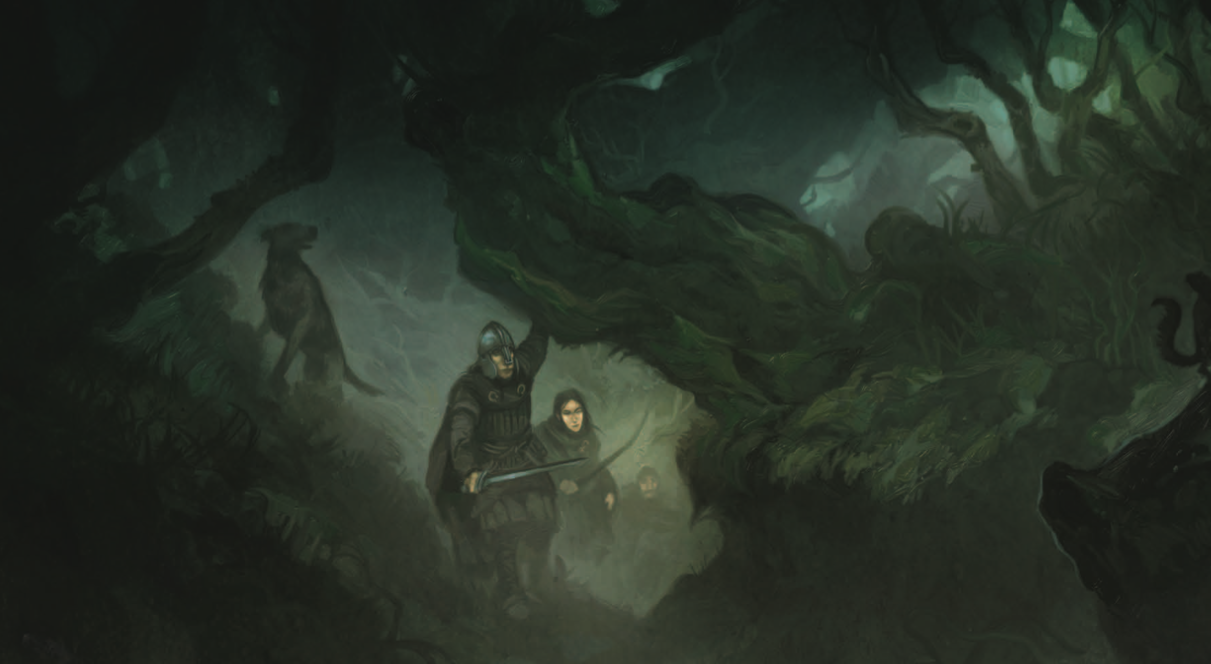Playing the Dunedain Rangers of the North: Lord of the Rings Lore
The Dunedain Rangers of the North have a long and bitter history that you should have an inkling of if you play one in The One Ring RPG 2nd edition. Get to know the Ranger of the North culture and spark some ideas for an interesting character.
Credit: Cubicle 7-artist Mauro Alocci
I'm going to take the easiest guess and say that most parties that form in The One Ring RPG 2nd edition will likely include a Dunedain Ranger of the North.
I mean, when I created an article showing how to create a character in the game, even my example was a Ranger.
I get it.
You want to be like Aragorn.
The scowling.
The smoking next to a fire in the Prancing Pony.
The long, perfectly messed up hair.
The didn't-have-time-to-shave beard. (Even though Aragorn probably didn't grow facial hair according to the nerds on Reddit. Because he has Elf blood back somewhere in his family tree–to answer your inevitable question.)
You want that brooding, incredibly kick-ass, but, overall, sexy as hell Ranger of the North.
Who wouldn't?
But there's more to the Rangers in Lord of the Rings lore than looking foul and feeling fair.
So, let's help you make a lore-accurate rendition of a Ranger that helps your character feel more in line with Tolkien's vision and helps you have a lot more fun role-playing them.
How the World Sees Dunedain Rangers of the North
Only a dozen orcs? Finally, a fair fight! Credit: The One Ring Adventurer’s Companion Sourcebook
I'm starting with this point on purpose. One of the most obvious things about the Rangers of the North is how the world around them reacts to their presence.
I would argue it's even more important than getting into the Númenórean blood and lost kingdoms of the North stuff. The day-to-day for a Ranger largely centers around how the people of Bree and the surrounding area view them.
And that's generally with a ton of mistrust.
When you smell like sweat, boar hide, and tobacco, people will look at you with a hint of disgust. And that's just the tip of the iceberg.
As a Ranger, you're a wanderer (whether that's your Calling or not. Yes, I know it's Messenger in The One Ring 2nd edition–let my tiny joke slide, rules lawyer.)
As a wanderer, you aren't a part of the community. That leads to instant distrust. If you were an honest and upstanding individual, why wouldn't you live in town or farm in one of the communities around Bree?
So, the simple logic of people like Barliman Butterbur is that you must be up to no good.
To make matters worse, there are plenty of rumors about Rangers that are both true and far-fetched. At the very least, there's enough to make some rushed conclusions about the kind of person you are as a Ranger.
Ruins and old fortifications, thought to be haunted and unsavory, seem to be frequent stops for Rangers. The only kind of person that would want to risk making camp in such places must be a brigand. Who else would do such a thing?
What the hell are those Rangers up to? That's the question on everyone's mind, and whenever you come into town, you're almost instantly recognized.
First, you're filthy.
Second, you're not recognizable (not being a part of the tight-knit community and all.)
And Third, there's a Dunedain “look” about you.
Dangerous folk wanderin' the wilds.
To add to these rumors, no one even knows your rightful name. Aragorn is known as Strider. (Pretty important for his real name to be a secret, so it works out for him.)
So there's a fun One Ring RPG thing–pick your character's name, but also, what's the name that Bree gave you or something similar?
Aragorn sums up what the Rangers do and how they're perceived when talking to Boromir during the council of Elrond. He responds to Boromir talking about how Gondor does all the work, but Aragorn sees the bigger picture:
“Peace and freedom, do you say? The North would have known them little but for us. Fear would have destroyed them. But when dark things come from the houseless hills, or creep from sunless woods, they fly from us. What roads would any dare to tread, what safety would there be in quiet lands, or in the homes of simple men at night, if the Dunedain were asleep, or were all gone into the grave?
`And yet less thanks have we than you. Travellers scowl at us, and countrymen give us scornful names. “Strider” I am to one fat man who lives within a day’s march of foes that would freeze his heart or lay his little town in ruin, if he were not guarded ceaselessly. Yet we would not have it otherwise. If simple folk are free from care and fear, simple they will be, and we must be secret to keep them so. That has been the task of my kindred, while the years have lengthened and the grass has grown.”
You get a sense of how infuriating this is to Aragorn, but he knows it's the only way to protect the regular people of the North. That burning fury is something to consider making your character too, and can play into your Shadow Flaw.
As a side note, Aragorn seems to be especially frustrated with Barliman Butterbur, who has no love for Aragorn earlier in the books either. The amount of times Aragorn fat shames him is concerning.
Also, how was that meeting when Aragorn came back as King? This vagabond that Butterbur was barely willing to sell ale to now claims to be King? Pfft.
Speaking of bloodlines and lineage.
The Blood of the Dunedain Rangers of the North
Finally my purpose in Middle Earth draws near….the perfect fishin’ hole. Credit: The One Ring RPG Bree Supplement
In that meme-able scene from The Two Towers where Eowyn makes terrible stew, Aragorn claims to be 87. I hope I look that good at 37, let alone 87.
That's because the Rangers of the North have Númenórean blood, especially those with any import like Aragorn. It gives them a longer life than regular Men (pfft, losers), and I've always wondered if that was partly why they were so hated in the North.
“That's the guy my father used to talk about, and he looks the same! And I started balding at 24! But look at his luscious locks! Must be evil!”
If you want to go way back, a Ranger of the North is a distant descendant of the Edain. They were the Men who fought alongside the Elves against Morgoth (essentially Sauron's boss, but you probably already know that.)
So, your very foundation is that of fighting the darkness.
It's party because your ancestors stood against the Shadow that your Ranger of the North is blessed with long life.
A Ranger's ancestry then traces its background to Númenor, which is similar to the Atlantis of Lord of the Rings lore.
Thanks to their great culture and seafaring ability, they were later able to help defeat Sauron in probably spoiler-y things for the Amazon show.
But what's most important here, while you role play your character, is that Númenor was swallowed by the sea.
Why?
Many of the Númenóreans decided that worshiping the Shadow was edgy and cool. Probably exactly how Tolkien described it, actually.
Those who resisted made their way from the destruction with Elendil, an ancestor of Aragorn and father of Isildur–you know, Isildur who kept the Ring and kinda screwed everyone over.
The point is, your Ranger has the noble blood of those Men who raised middle fingers to Sauron and established the kingdoms of Arnor and Gondor in Middle Earth.
There's a ton of history there, and as we see in The Lord of the Rings books and movies, Gondor is still around during the Ring saga.
It's the lost Kingdom of Arnor that is probably closest to a Ranger's heart. But, more on that in a sec.
What you need to be thinking of is that split nature of your Númenórean blood. It’s capable of so much good, but also holds many failures. Your stand against the Shadow is built into you, but you aren't above its corruption.
Makes for a pretty damn interesting character. Like all real human beings, you have flaws, perhaps big ones, like fat-shaming poor, simple Barliman Butterbur.
(I mean, Butterbur is a hell of a name to live up to.)
And your Ranger of the North has many great names to live up to as well.
One of the Cultural Virtues for Rangers in The One Ring 2nd edition is the ability to make a wondrous item or famous weapon passed down for generations to your character. Númenor, the realms of Arnor, the many wars against Morgoth and Sauron, all are ripe for some special item from your family.
Your Dunedain Ranger lives in an interesting wedge of time. They are right in the middle of kingdoms lost and desperate hope for a new future.
Dunedain Rangers of the North and What Has Been and Could Be
Is it a good idea to stare directly into the sun? Meh, I’m sure it’s fine. Credit: The One Ring RPG 2nd Edition Rulebook
It would take a history book (or entire show) to explain everything about Númenor, its fall, and everything that came after, so I don't want to go too crazy for this article.
If you didn't know, Lord of the Rings lore is kinda vast.
But your Ranger of the North character would sure have history on their mind.
Arnor, as mentioned earlier, is closest and dearest to the Rangers wandering the wilds. They all have ancestral lands that lay in ruin, scattered about the landscape. There's some real emo potential here as your Ranger may get Big Sad looking at what was lost.
And because this is your once-great ancestral home, you still protect it. What fuels all that secret guardian stuff we looked at earlier is your connection to the lands that once were.
Arnor in the North was categorized into three kingdoms.
Arthedain, Cardolan, and Rhudaur formed the three regions in Arnor where a Ranger's people made their lives. And there were some great cities and incredible landmarks. We even see some in the books and movies, like Weathertop.
Amazing map of the three kingdoms of Arnor from Master of Lore.
Bree itself was a trading center located at an important juncture in the road. Those living in its walls don't even realize much of its connection to what once was. And here you are, a direct descendant of those noble people, scorned in an inn by people who know nothing.
Now you can see a little more about why Aragorn had a chip on his shoulder.
There were a lot of factors that brought about the fall of Arnor, much like the fall of Rome.
There were terrible, cold winters, famines, great plagues, but the topping on this terrible cake was the Witch King of Angmar.
From the lands of Angmar, the greatest of the Ringwraiths waged war against the Men of the North after the fall of Sauron and the chopping of his fingers.
Things were already not looking great. Arnor became its own thing after Isildur's death, where he promptly loses the most important item in Middle Earth. (At this time, anyway–don't come attacking me with “what about the Silmarils?” please!
The North was dwindling, and the Witch King cleaned up the rest. He takes the great fortification at Fornost north of Bree, and it takes everything the remnants of Arnor have to get rid of him. This is where the famous prediction that the Witch King will be killed by “no man.” ™ ™ ™
The forces of evil are defeated, but the last of Arnor goes with it.
The Rangers of the North form out of this desolation.
Now, the Rangers guard what's left of this kingdom and hope that one of their Chieftains is made King again.
Enter Return of the King. Spoilers. I mean, right there in the title and everything!
That tension is on your Ranger's mind, at least a little. I mean, it would be for me! Here you are, an awesome version of Men, and you have to just...wait. And hope.
Hmm, there's a character idea.
Character Build Ideas for the Rangers of the North Culture
Damn look at that rock! You don’t need a sword, just start punching orcs! Credit: The One Ring RPG 2nd Edition Rulebook
Let's get into some One Ring RPG 2nd Edition mechanics. Or at least ideas.
Knowing all this good lore stuff and how the world sees a Ranger of the North, let's get some inklings of character concepts going. These are just ideas; I hope they help your creative gears start turning.
1. The Impatient Ranger
I love the idea of a young Ranger that wants to start taking more action against the ever-growing darkness around Bree.
The Rangers of the North must be sensing a change in the in-between time of The Hobbit and The Lord of the Rings. There are decades of growing Shadow, from Barrow-wight restlessness, to walking trees, to orcs and trolls coming out of the mountains and the North.
Then the Rangers double their guard of the Shire. (That's a little later, but still.) Sus.
And most of that time, Aragorn isn't around. He spends DECADES of his life in Rohan and Gondor to the south fighting orcs and being awesome.
Which is great for him, but what about a young Dunedain Ranger who's told their Chieftain is somewhere else and they need to be patient?
Seems like some good tension to me!
A higher Strength and Heart score makes sense here. You haven't developed the patience of your peers or the insight of older Rangers. Your body is ready for battle, and you haven't seen so much darkness yet that you have the same weight as others of your kin.
And I'd invest in Valour first and Wisdom later. Any Cultural Virtues you do get would should relate to fighting and hunting the Shadow, like Strength of Will and Ways of the Wild.
In terms of Callings, Champion and Warden stand out the most here. I especially like Champion since their Shadow Flaw leans into that vengeful fall from grace.
2. The Scholarly Ranger
Not all Rangers are Aragorn rip-offs.
But even with Aragorn, there's an educated, Man of the 4th Age, quality about him. He sings. He cries. He's a World War 2 buff. So to speak.
Lean into that side of being a Ranger of the North.
Sure, you have your strength still, better than most other Men, but compared to most Rangers, you'd rather read ancient texts than fight off wolf packs.
In fact, protecting these uneducated, simple Middle Men is a little frustrating.
This mentality can clash with your mission to protect, and probably sees some clash with other Rangers for that reason.
Or you could try to give these farmers some learnin' that’ll be good for them. Which also reveals more than most Rangers give away about who they are.
This path can be dangerous because your solution to defeating evil might mean revealing secrets that should have been left unknown. The ruins of Arnor hide many things, many of which are not exactly great.
Get a Wit score deserving of your studies and move your Wisdom up as you level early on. This gives you access to some pretty great Cultural Virtues early. Take the Heir of Arnor and give yourself and sweet item or weapon.
And get creative. Maybe that item wasn't passed down to you but was in a secret location you discovered, you legendary book-worm, you!
Scholar is the obvious choice for a calling, but Messenger is also good.
3. The Tomb Defender
Some say the best defense is actually a good offense. Tomb robbers can't rob tombs if they've already been cleared out.
You need to collect as much as possible from the ancient ruins scattered around the landscape to ensure your culture is preserved.
There are more than a few bands of thieves and murderers that wouldn't mind getting their hands on some ancient gold, jewels, or perhaps, something more precious.
It's up to you to make sure they don't get anything too important to your Númenórean blood.
But that means defiling the graves of those who were lost to Shadow. Not only is that plain rude, it's also very dangerous. And frowned upon by Ranger and Bree-lander alike.
You have some sneaky Wit about you, but being around so much darkness probably hinders your hopefulness.
Heir of Arnor is another great Virtue to take early, or even Royalty Revealed as you use your ancestry to inspire those around you.
Treasure Hunter is the obvious choice here, but I love the reverse nature of the motivation. You're treasure hunting to keep treasure hunters away from treasure. Phew!
Making a Fun TTRPG Character
What's important is you make a character that's a blast to play.
Sure, you can memorize the entirety of Númenórean history and all that went into the complicated fall of Arnor...
Or you can grab our handy Character Creation Cheat Sheet that makes it super simple to create a character in any TTRPG format.
It keeps things simple but immerses you in the pillars of your character so you can have fun playing them no matter how long the campaign goes.
Get your free PDF right here, or click below; just tell us where to send it.
Lord of the Rings Places: Mirkwood Forest
Mirkwood forest in The Lord of the Rings is full of darkness and danger. Dive into the lore of Mirkwood forest and the literary symbolism of forests used throughout history, including in The Lord of the Rings.
Entering Mirkwood (Credit: The One Ring RPG)
If there’s one thing that’s guaranteed to be in a fantasy story, it’s a dark, scary forest that may or may not have a candy-hoarding witch in it.
For the people living in Middle Earth, Tolkien skipped the whole witch thing (in this particular forest anyway) and went straight for something a million times worse: spiders.
But Mirkwood Forest hides more secrets than just spiders in there. In fact, Mirkwood forest wasn’t always Mirkwood.
We’re going to dive into the history of Mirkwood, the dangers inside, and what forests represent from a literary standpoint. Tolkien sure loved using their symbolism, and there’s a good reason why.
And, since our crew is running through The One Ring RPG on our actual play podcast called The Party Business Podcast, we’ll also look at how you can use Mirkwood as inspiration in your own tabletop campaign.
So, let’s stay on the path or risk getting lost in the lore of Mirkwood in The Lord of the Rings.
The (Summarized) History of Mirkwood Forest in The Lord of the Rings
Thranduil’s Halls by John Howe
Here’s the thing...if we dive into the details of the history of Middle Earth, this article is going to be tens of thousands of words long, and I’m still going to miss a ton. It’s like studying actual history, that’s how dense it is.
Ok not really, but you get it.
Let’s keep it simple.
Early on in the Lord of the Rings history books, there were a ton of forests. More accurately, I should say that they were all one big forest covering most of Middle Earth. And Middle Earth, in the early days, had more to it before a lot of the western stuff ended up at the bottom of the ocean.
BTW “western stuff” was definitely the term used by Tolkien...he was big on linguistics, after all.
Mirkwood forest was a part of this big ass forest that covered just about everything. It may have even been connected with Lothlorien at one point.
As that was cut down by Men (typical), smaller portions of it were left behind, making up the forests Lord of the Rings fans know and love. The Old Forest near the Shire, Fangorn Forest, and Mirkwood are three that definitely have the remnants of that ancient, vast tangle of woods.
Any forest with walking trees and willows that try to eat Hobbits is pretty old and has some emotional baggage from people trying to cut it all down.
But Mirkwood, at this point, was known as Greenwood the Great. Not the most clever thing the Elves ever named, that’s for sure. I’m sure there’s an Elven word for it that sounds beautiful. But it was green, and it was the woods, and it was really big: Greenwood the Great.
Great work y’all.
Now, this is before spiders and dark branches clogging up the air in the forest. Elves settled here, the Silvan Elves, which is an important distinction since, apparently, as they weren’t as cool and magical as the High Elves like Elrond and Galadriel.
I always found it funny that Tolkien makes that reference in The Hobbit. I guess these are the Duck Dynasty Elves or something. Remember that show? Didn’t think you would see a reference here, did you?
But they were still Elves, so they’re automatically better than just about everyone else. And they know it too, those cocky bastards.
Then, Sauron starts tricking everyone with these super lovely rings (I’m summarizing a couple thousand years here.) The Elves figure it out, and a whole war starts as Sauron tries to get all the rings he made back and uses his One Ring to kick everyone’s ass.
The Last Alliance of Men and Elves (that we see at the very beginning of the Fellowship of the Ring movie) defeats Sauron...kind of...and some of those Elves return to their homes, including Mirkwood.
As time goes on, Sauron starts getting his groove back and enters Greenwood the Great. He builds Dol Guldur, a fortress in “modern” Southern Mirkwood, and starts tainting Greenwood the Great. Over time the forest gets so dark and gross and spider-y that the name is changed to Mirkwood or the Forest of Great Fear.
The Forest of Great Fear isn’t exactly what you want to see on your National Park map.
The return of Sauron (known as the Necromancer at this point) brings a lot terrible things to Middle Earth, including a plague. I won’t go into details because the last thing you want to read about right now is a plague, I get that.
But Mirkwood becomes what we know it as: dark and terrible.
Also, fun fact, the spiders in Mirkwood are mostly the offspring of Shelob herself.
Sauron in Mirkwood Forest
Mirkwood Forest by J.R.R. Tolkien (yup he could draw too)
Let’s look at dates for a moment.
The Hobbit book takes place in 2941 in the timeline of Middle Earth. That means...spoiler alert, I guess, for a book you almost certainly have read because I really doubt you’re looking up Mirkwood otherwise...The Necromancer is driven out of Dol Guldur by Gandalf and the White Council “off-screen” as we follow Bilbo’s journey.
But Gandalf figured out that The Necromancer was Sauron in 2850. Bro! That’s nearly a hundred years of sitting on that information! Everyone takes forever to do anything against Sauron until, finally, Frodo leaves with the Ring. Which also takes forever for him to leave! It’s like 17ish years between Frodo leaving the Shire and Bilbo’s party.
But I digress. Just like...be more efficient, and maybe darkness has way less of a chance.
Anyway…
Sauron actually has a couple of stints as the Necromancer in Mirkwood but what’s important is the darkening of Mirkwood is directly his fault. Jerk.
Bats, spiders, and orcs make Mirkwood pretty uninhabitable. There was a very nice Dwarf road called the Old Forest Road that was unusable with the arrival of Sauron. (Orcs create abysmal traffic.)
The Elf Path that the Dwarves and Bilbo use in The Hobbit is made by the Elves and protected with their hick-elf magic, but it’s still a tough road to use. It’s so narrow, it can’t really be called a road.
Mirkwood forest gets so dark and dangerous that leaving the path is a damn foolish idea. And for a while, literally, Sauron is out there somewhere in the darkness.
What’s interesting to me is what happens after Sauron is cast out in The Hobbit. Smaug the Dragon is also dealt with, and trade flourishes again in the area for a little while. There are still, like, 78 years between The Hobbit ending and the Ring being destroyed.
That’s a lot of time for a story or two.
There are some things we know from the appendices at the end of The Return of the King. First, the darkness grows again, and Thranduil, in charge of the Mirkwood Elves and Legolas’ dad, has to fight back orcs in the forest as the Ring travels through Mordor.
At the same time, Galadriel and the Lorien Elves march to Dol Guldur and take it down.
While all that stuff is happening, Dale and the Lonely Mountain have their own battles repelling Sauron’s forces as the actual last battle in The War of the Ring. (Besides that whole Shire thing that happens in the book. Yes, I know the Battle of Bywater is the actual last battle, don’t @ me.)
Honestly, Amazon’s Lord of the Rings show should have been about all the Mirkwood and Lonely Mountain stuff, but whatever.
But for a little tiny sliver of time, there was peace but a growing worry about the return of darkness.
And that’s a story that will get told, but more on that in a sec.
Mirkwood Forest and the Literary Symbolism of the Woods
Mirkwood by Alan Lee
Forests in fairy tales and folklore are deeply rooted (get it) in our human psyche.
When humans were scraping by to survive, the forest was a double-edged sword.
On the one hand, forests provided much-needed materials. Wood, food, water sources, and shelter were just a few things our ancient ancestors needed from forests. That we honestly still need from forests.
But the darkness of the forests revealed a risk in getting those resources. There were plenty of actual dangers to worry about, but forests represented something even greater than those realistic worries: The Unknown.
The imagination is a great and terrible thing. The forest represents challenges, gifts, dangers, provisions, and a vast sea of hidden things. And if humans can't instantly understand something, they start making shit up.
The forest is the perfect setting for those things because entering the trees means leaving the known and taking a chance on something new. And new is exciting and scary at the same time.
In literature, “crossing the threshold” is a key component of the Hero's Journey. We don't really like stories that stay in the safety of the known forever and then end. Pretty boring. (Even if the cast of The Party Business Podcast laments for a pleasant stroll through the Shire constantly.)
Stories that take us into the unknown and challenge the characters are what we want to read. That means having to cross the threshold into an alien world. And the forest provides the literary playground storytellers need to force change upon their characters.
Think about Bilbo's journey in The Hobbit. It's through the trees that he has to sneak up on three trolls and begin to prove himself.
After gaining the Ring and building at least some of his confidence up, the forest is where he is left utterly alone to rescue not only himself but his companions.
And that place is none other than Mirkwood Forest itself.
The forest is a magical place–one of transformation. You go in one thing and come out another.
We still do this today. Camping is the escape from reality. Go on a hike a weary human of consumerism and anxiety, then come out the other end in tune with your roots as someone belonging to nature.
Or some crap.
And it wasn't just handed over to you–you have to earn it. You have to struggle through the hike, sweat a little, deal with your allergies, whatever the case may be. The trial of the forest might not mean facing actual spiders, wolves, and witches, but the symbolism is still there.
Tolkien, being the lover of fairy tales and mythology, did not let the importance of the transformative power of forests get away from him.
Mirkwood changes Bilbo as he saves the Dwarves from spiders.
The Old Forest reveals the dangers of the quest to Frodo, Sam, Merry, and Pippin, testing whether Frodo is willing to sacrifice himself for his friends.
Fangorn Forest forces Merry and Pippin to take a stand in the fight they have been whisked off into.
Lothlorien represents something truly ancient, magical, and possibly dangerous, even as the Fellowship gains new gifts and rest.
And I find it interesting that Mirkwood specifically goes through the change that it does. It's reduced to its boundaries in The Hobbit by greedy Men. It's cared for by the nature-loving Elves. But the Elves aren't going to be around forever. And orcs, in general, chop every tree they can find. They are the ultimate utilitarians seeing only a resource where the Elves see so much more.
Which leaves the question of what will happen to these forests when Elves leave and the orcs are all by wiped out? The race of Men are the middle ground. Will they lean more towards caring for the forests, or harvesting?
Tolkien certainly wasn't trying to say anything. Nope, not at all.
Mirkwood Forest in The Party Business Podcast
Credit: The One Ring RPG
I said earlier that I would go into more about that mysterious time in Mirkwood's history right after The Necromancer is driven out.
And I am.
Because there's a story being told about that time in our One Ring RPG actual play podcast. The Party Business Podcast sees a group of 5 companions facing the dangers of Mirkwood.
The start of our story has them crossing it, going from the east side of it to the west side—kind of like The Hobbit, but backward.
And it begins their own transformative character arcs. Some might not even come out the other side.
The ambiguous nature of Mirkwood makes for some fantastic room to play in too, as a storyteller. As the Loremaster running the game, I may have some truly crazy stuff for them to face.
It’s the freedom of the “nameless things” Tolkien talks about in The Lord of the Rings. The dark shadows of evil that can take the shape of just about anything.
Orcs and spiders? Sure. But what about great wolves infused with dark magic? Or wights that have entered the trees themselves? Or great bat creatures that drain your blood?
Fun fact: werewolves and vampires exist in The Lord of the Rings universe. Just sayin’...
But, let me be real here for a sec:
Starting an actual play podcast is kind of like going into a forest in of itself. I don't know what's going to happen in there. Are we going to be lame? Are we just a bunch of geeks that laugh at each other but others would just roll their eyes? Are we...uncool?
I mean, yes, we are, but that's because we started a One Ring RPG podcast, so nuff said.
But I'm someone that loves listening to The Adventure Zone and The Glass Cannon Podcast. I know what a good time sounds like. Can we manage that in The Party Business Podcast?
Even in Episode 1, which was a two-parter, there's something special that starts happening. The friends that joined me are hilarious and have crafted such cool Woodsmen, Beornings, Hobbits, Bardings, and Dwarves that I genuinely love listening to our own episodes.
That only gets better in Episode 2. I hate, yet love to say it–we already feel like we are hitting a stride, which means it’s only going to somehow get even better.
So if you want to see how the darkness returns to Mirkwood and what the unsung heroes of Middle Earth do about it, listen to The Party Business Podcast wherever you get your podcasts.
And if you're a geek like me, and the rest of the Party Business crew, then you probably play tabletop RPGs. That means you also probably spend a ton of time crafting characters.
Have you ever had one that just fell flat or didn't have the depth you hoped for?
We have a solution for you.
Our character creation guide is free and has simple steps to making a deep character that is a blast to play at the table no matter what game you are playing. D&D, Pathfinder, or...The One Ring RPG...these tips will help.
A lot of advice comes from crafting engaging literary characters, simplified to make it work for a character that's easy to make in a tabletop RPG.
So click here to get it emailed to you, or use the form below.



